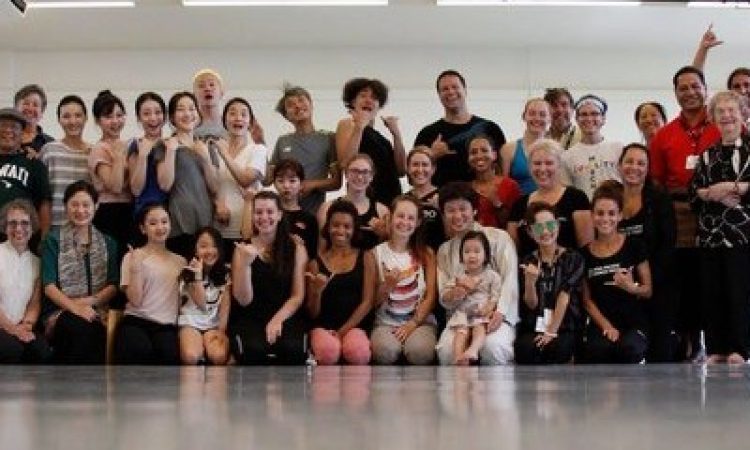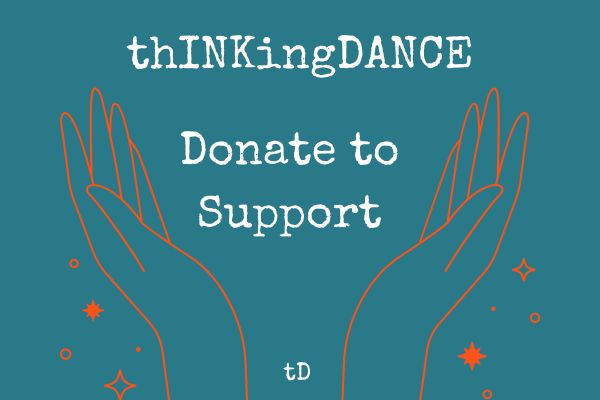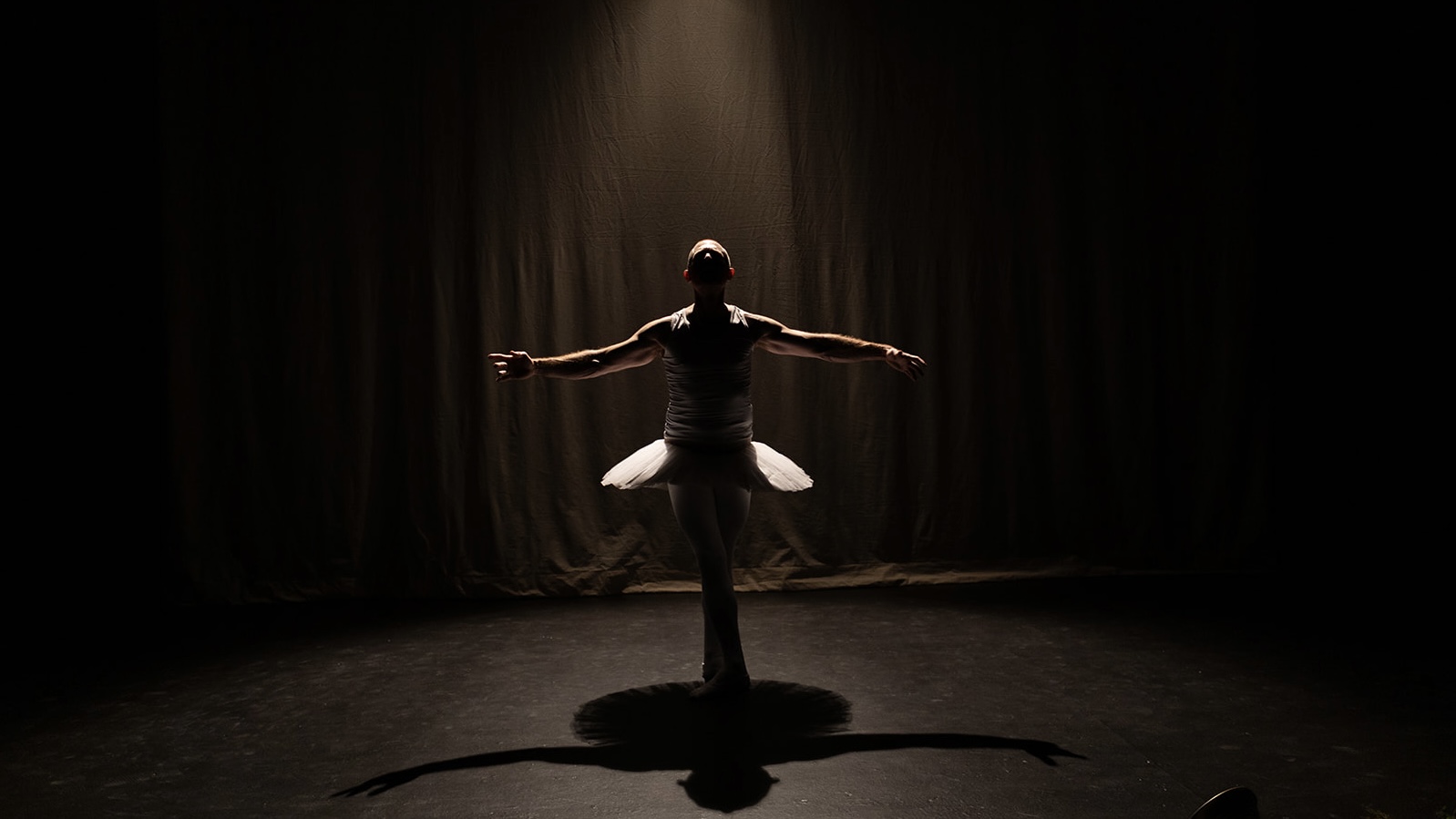July 25
On the first morning of Intensive classes, Maelia Loebenstein Carter opens with a ritual chant. It’s deep and husky and tremulous, sweet and scary. Later, after hearing her speak repeatedly about hula’s connection to the land and nature and lineage, I imagine it sourcing from the lava of her island, from ground made fertile with the bones and spirits of her ancestors. Her class always begins and ends with this chanting.
Maelia’s forebear and inspiration is her grandmother, Mae Ulalia Long Loebenstein. As a seventh generation kumu hula (master teacher of Hawaiian dance), Maelia is responsible for carrying on her grandmother’s legacy. Along with steps, she’s charged with conveying the worldview encoded in the dance’s lyrics and gestures—a reverence and appreciation for the physical world, for unseen forces, and for her culture’s shared stories. There’s profound depth there. Is that what we’re hearing in her voice?
In a 2012 workshop with thINKingDANCE writers, the dance scholar and writer Suzanne Carbonneau screened a dance video, then asked us “why does it matter?” Dance writers generally cover what happened during an event, and often report on its context and what was effective or not, but we don’t always answer the question “why should anyone care about this?”
As witnessed in multiple presentations and classes, the Tongan, Korean, Hawaiian and Okinawan dancers at this year’s Asia Pacific Dance Festival at the University of Hawaii at Manoa (UHM) all shared dance practices that are deeply embedded in their cultural traditions. For people with connections to these cultures, the dances provide a rich re-affirmation of cultural identity. For those less familiar, they provide a window in. Watching the performances alongside people in the know, who whoop and holler, or plaster dancers with dollars or even join in (depending on the dance form’s conventions), we can feel how moving and nourishing these performances are. They matter a lot.
The Asia Pacific Dance Festival Intensive spanned the two weeks of the festival and included morning lectures on the dance forms as well as three movement/repertory classes a day. Students who danced alongside the Tongan, Korean, Hawaiian, and Okinawan dancers received a genuine physical transmission—an embodied experience of those cultures. With that came the felt understanding that through dancing, there’s connection. As the Okinawan dancer Yukie Shiroma said at the Festival’s close, “Once we meet, we are family.”

In Hawaii, dancers who train together in a “halau” (dance school) are considered “ohana,” family. They refer to each other as dance sisters or dance brothers. Another kumu hula, Michael Pili Pang, hosted a dinner on the eve of the Festival’s start for the directors of its dance companies and APDF’s main movers. In the building that houses both his home and halau, the studio takes up most of the ground floor. It’s ringed with containers for costumes, props and instruments. Photos of his teachers and favorite dancers grace the walls. Two wide garage doors at either end permit opening the space to the outdoors, and, I’m told, creating party spaces adjacent to the dancing. Even in the empty space, you feel the interconnection of the dancing with social togetherness.
Pili Pang’s loft-like upstairs floor is ideal for hosting, and he explained that it’s used as workspace. The big table on which the halau fabricates costumes is the one where his grandmother entertained her thirty grandchildren. After scrumptious food, the most gregarious artists hopped up to offer bits of performance—a snippet of opera here, a bit of wonderful Tongan dance there—eventually inspiring even the shy among us to share a heartfelt poem or amusing song, making us feel more connected. Like family.
July 27
Pili Pang presides over the first formal performance of the Festival, Living the Art of Hula, an evening centered on the form known as “Hapa Haole” (meaning “half western”). The evolution of this sometimes-contentious form becomes more understandable once you hear that, in Hawaiian tradition, if a chant is written about you or in your honor, you are its “owner.” So when mainlanders in early 20th-century Tin Pan Alley took Hawaiian imagery (the lovely hula girl under swaying palms in the moonlight) as their inspiration for songs, the Hawaiians’ re-appropriation of this English-language music makes sense. Continuing through the decades to 1959, it provided a soundtrack for dance as the Hawaiian’s indigenous language was suppressed.
These dances look like what you’d imagine in a floorshow at a big resort hotel, and indeed one of the featured dancers, Kanoe Miller, has performed at Honolulu’s Halekulani Hotel for forty years. The dances are sweetly sexy, sultry with swerving hips and a ready smile rather than a come-hither provocativeness.
A dance to the song “Hula Hands,” performed by a large group of older women, receives an enthusiastic reception. The delight on their faces and the tenderness in their unfurling fingers seems to convey the depth of their love for this dance form. I wonder: why such a response for this, over many other entertaining numbers? A companion tells me it has to do with the profound respect Hawaiians have for elders.
July 28
After showing a video of a contemporary Korean spectacle, Moonae Choi looks at me and, in a room full of dancers and scholars, seeks my response. “I am trying to figure out how I am looking,” I say. As an “outsider” my more practiced responses, informed by an understanding of the context in which a dance is done, are of no use here. What may look overly dramatic to me may strike just the right emotional chord in someone of the originating culture. So the first thing I experience is doubt.
A zen story applies: A student is given a cup by the zen master, who continues pouring in tea until the cup overflows, then says “If you want to learn zen, you must first empty your cup.” To see properly, I must empty my mind of concepts of what is “good” dance, and let go of whatever values I associate with it.
And yet, there are ways in which I connect readily. When Kim Samjin, in her class on Korean creative dance (a form based in tradition, but stretched with influences from the West and other innovation), demonstrates a walk synchronized with her breathing, I am spellbound. Her arms lift slightly as she steps forward, her body softens just a little as she exhales, letting her weight settle fully on the foot. What is the magic in that?
Kim explains that her movement comes from the heart. And you feel exactly that. Her demeanor is gentle, retiring even, but her movement is complete and riveting in its fullness. It’s a perfect example of something Sal Murgiyanto, my dance critic counterpart from Java, speaks repeatedly about. He cites two factors vital to being a worthy, compelling performer, and the first is that you need to be a decent human being. The most powerful dancing is from the heart, and to communicate in that way, the dancer needs to develop themselves inwardly along with mastering technique.
Sal’s second criterion for powerful dancing is with regard to whether it’s intended to “express or impress.” He equates the latter with commercial forms and theatrical performances intended largely as entertainment. Dance bling. He implies that there needs to be a balance, or at least, a good helping of expression. While fostering the work of younger artists in Asia, Sal has been a powerful mentor, encouraging experimentation and ways to create dance that reflects these values.
July 29
A page in my notebook is filled with questions that seem essential to answer, at least in part, in order to be able to comment meaningfully on any of these dances.
How does the dance connect to the wider community?
What does it say about a community’s world view?
What is considered beautiful, pleasing, or worthy in performance?
What are the stories told or ideas communicated through the dance?
What does dancing say about the relationship of the individual to the group?
How does it express the nature of the place where it originated?
Are we moved in some way? Is that an aim of the dancers?
What are differences in gender roles and expression?
Who dances and who is it for?
How are music and dance connected?
How is the legacy of the dancing carried forward? Who is empowered to evolve the forms? Who “owns” the dances?
How do cultures effectively preserve cultural legacy while allowing or even stimulating artistic evolution?
July 30
Cape Breton Island, Nova Scotia, is a model of emigrants faithfully preserving their homeland’s cultures. There are forms of Scottish music that remain largely unchanged from the time Scots emigrated there in the 18th century. They are more faithfully preserved than much of what you can hear in Scotland. When far from one’s original homeland, the importance of maintaining culture accurately is amplified.
Similarly, for the many Okinawans who have migrated to Hawaii, a nexus of pan-Asian cultures, the preservation of their dances holds a vital place. The dances are “identity markers” through which the dancers know themselves to be Okinawan.
In Dū usami: the Journey, nine short pieces are followed by an extended dance-drama from 1719. Dancers trained by Cheryl Yoshie Nakasone, a lineage holder of Ryukyu-style Okinawan dance, perform unison abstract gestures and crisp walking patterns with an often plucky, percussive sound score. As with Tongan and Hawaiian dance, these dances begin with words or a poem. Some of the themes are also like those found in those other forms, as with “the joys of living on an island paradise,” or specific aspects of nature, or harvest, or love stories.
Nakasone herself portrays the heroine of Shūshin Kani’iri: a lonely woman who after unsuccessfully pursuing the object of her affections, turns into a demon. It’s all in highly stylized, Noh and Kabuki-inflected action. As an island nation situated between the influential cultures of Japan and China, Okinawa’s forms fused aspects of those two. But when, in 1879, the Okinawan kingdom was dissolved by Meiji Japan to become a Japanese prefecture, artists were no longer court-supported and turned to more “entertaining” forms with quicker tempos, flashier costumes, and stories about commoners. Thus, this old dance-drama would rarely be seen in Okinawa itself.
The singing and playing of the uta-sanshin (an instrument related to the shamisen) by Kishun Nishie, a Living National Treasure (a title Japan gives to people who are “Preservers of Important Intangible Cultural Properties”), is a highlight. His voice especially recalls the Japanese concept of wabi sabi, embracing the beauty in imperfection. It’s rough, and slightly salty, but highly expressive.
August 4
After all the resident dance groups have arrived, and as a prelude to a weekend of final performances (see review here), the Welcoming Ceremony takes place outdoors, cooled by the shade of wide-spreading trees, at the aptly named East-West Center’s Friendship Circle.
With the Queen of Tonga present, a gargantuan tapa—a mat pounded from mulberry fibers and decorated with geometric patterns—is unrolled and her chair is placed in its center. She wears black, as do her attendants, in honor of a deceased relative. Her hair is in a neat bun, her earrings and necklace ringed with pearls. Her bearing is elegant.
Dancing before their Queen, the Tongan men rev up the energy in their steps. Holding miniature wooden paddles, they insert little jerks of the head which, we learned in Adrienne Kaeppler’s lectures, signify delight. Here they register as big punctuation marks. The men’s wide stomping and powerful thrusting carry megawatts of power, and overflowing pride. Voices in lush harmony and a slit drum accompany them.
The sharp wind instrument that signals the Korean court dancers’ entrance pierces the air as they glide along the grass. In wide skirts with thin starchy layers of red, blue, and yellow, long sleeves and a wide band tied high on the chest, three placid-faced ladies reach their places and stand nearly still for the initial minutes. Their breathing, or maybe their imaginations, enhances this stillness, making it riveting. How can one do seemingly so little and have such a large effect?
Hawaiian kumu hula Maelia Loebenstein Carter’s dancers are adorned with leis everywhere—greenery rings their ankles, wrists and heads and larger leaves drape around their necks. These women, full of body and dressed in voluminous skirts and tops, look to be part of this land. The mountain ridge behind them echoes their muted brown skirts and caramel skin; the grass and trees, their leis.
This hula, riding on the sound of four gourd drums and four women’s chanting, rolls like the sea. The eight women’s hips sway side to side as their feet pad. A tiny flex of the knees offers a percussive spark as their rolling wrists and unfurling arms narrate the words of the chant. This hula belongs here. These women are learning the old ways, resurrected from the time before hula was banned in the 19th century. Newer hula is shown too, by a sinuous soloist in midnight blue velvet.
August 5
Her Majesty Queen Nanasipau’u of Tonga sits alone, and I notice that those assembled for the Culinary Celebration, myself included, seem intimidated to visit with her. Adrienne Kaeppler, the immensely knowledgable (and witty) Smithsonian-based Tongan dance scholar hovers nearby, as she and the queen are good friends. Still, a seat is there…for me. Overcoming my own hesitation, I ask if I might sit down. Together, we eat the exotic dinner prepared by multiple chefs (including a Tongan-inspired ceviche!), chatting the whole while. We talk about Tongans’ bodies and her efforts to educate them in healthy eating (they have historically had a poor diet, and suffer in great numbers from diabetes), about the wondrous dancers she has helped bring to the Festival, about her pleasure in helping many of those in the troupe travel outside Tonga for the first time in their lives, about her wish to stimulate creativity on the part of young people in evolving dance as it’s practiced in Tonga. I offer encouragement about that last point, and an idea of who might help bring it about.
August 7
Kara Miller and Amy Schiffner of UHM’s Department of Theater + Dance lead the Intensive participants in a contemplation: What about the festival has impacted or changed you? My answers:
- feeling the gentle spirit of hula. In this dance, connection to place and tradition and ancestry are made present in each moment.
- feeling what dance in community can mean. In several of these forms, anyone can dance and express themselves through dancing. The individual’s role is as one of many, often in unison dancing, but each with their own experience.
- feeling how it is to be in Hawaii with beauty everywhere. Danced culture is a way of collectively appreciating the beauty in flowers, sea, mountains, and people, a way of having a good life together.
- feeling the humility of these people. They practice their forms at a profound level, but are completely open, without arrogance, with a caring and kind spirit.
But above all I am most moved by learning this:
“Every mask has its own character which inspires you into shinmyǒng.”
At the end of his presentation on Korean masked dance, I ask Changyeol Heo about the connection of the personality of a given dancer with their ability to dance powerfully in the mask. His own countenance is always brilliant and joyous; it seems inextricably connected to the power of his form.
To answer, he introduces a vital aspect of his dance form—shinmyǒng. He says it’s “the spirit of life when one understands how to struggle with life,” and it “causes the individual to fly with the wind.” When one connects with it, he says, one can ignite the shinmyǒng in others. It “resolves resentment and pain in human life” and creates a “bond of community spirit.”
All the expressions of the masked dance performer are intended to rouse shinmyǒng in the audience. This creates a feedback loop—as the audience is uplifted, it spurs the performer on, and the performer in turn excites the audience further, raising their spirits. As explained by the Korean dance scholar Judy van Zile, a collective release of the heaviness of shared suffering is effected. If the shinmyǒng has been achieved at the end of the performance, the audience may be motivated to get up and join in improvisationally.
Each dance begins with a rousing chant. In class, Changyeol Heo gets each student to sound from their belly and call out sharply. His own voice could boom off mountains. I imagine small children following him wherever he goes. His body is spongy, supple, bouncing again and again on one leg, kicking out, each time a different hand gesture punctuating the landing. He’s like a perky snow lion.
One can’t continue feeling gray or colorless when doing this dance, or seeing it. I picture whole villages gathering around these masked dancers, as Changyeol described in his lecture, encircling performers whose presence promises laughter and amusement. The dances are satires of officials or fallen monks, or goofs on married strife. Long sleeves tossed from side to side or swirled in a calligraphy of cloth enhance the action.
In class, as onstage, Changyeol wears white. He is the picture of youthful energy and supple strength. During class his little daughter sits on his wife’s lap on the side of the studio but runs to him as class ends. Everyone joins for a photograph. Each ending of a series of classes finishes in just this way, with a group shot. Everyone present is invited to join, whether they have danced or not. Again, we are ‘ohana’—a dance family.
Postscript
On Labor Day my Northwest Philly neighborhood held a big old-time block party with barbecue and a DJ. Most of the day I was holed up wrestling with this writing. But toward the end of the party I wandered over and there were still folks eating and dancing. One after another the DJ spun the tunes for soul line dances. The moves are simple, but there’s a funk and spirit to them that’s infectious. We’d bump our hips out, shuffle, step with emphasis onto one or another foot. Here was a local parallel for what I witnessed in Hawaii. And, after thinking quite a bit about the differences between the kinds of theatrical dance practice I’ve been involved with lifelong and these largely community-based forms, I decided to try something new, signing up for a series of line dance classes just up the hill from where I live—why not dig in and bloom where I am planted?
Asia Pacific Dance Festival and Asia Pacific Dance Festival Intensive, July 25 – August 7, University of Hawaii at Manoa. http://manoa.hawaii.edu/outreach/asiapacificdance/






